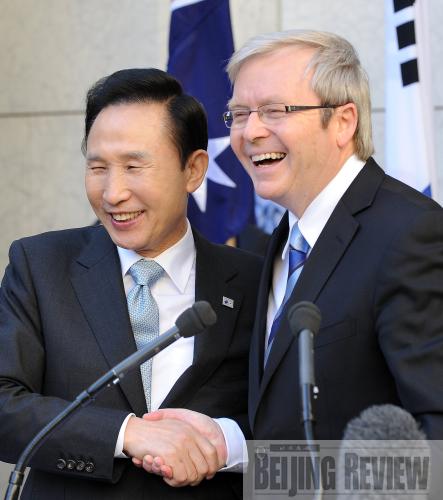|
 |
|
CLOSER RELATIONS: Indonesian President Susilo Bambang Yudhoyono welcomes visiting South Korean President Lee Myung Bak on March 6 in Jakarta (YUE YUEWEI) |
South Korean President Lee Myung Bak visited New Zealand, Australia and Indonesia in early March, introducing a brand-new diplomatic concept during an important speech at his last stop in Jakarta. Lee's "New Asia Initiative" and related policies are expected to help South Korea weather the economic crisis at home and abroad and promote regional cooperation.
The basic content of the initiative is to enlarge South Korea's diplomatic focus on China, Japan, Russia and the United States to a wider range that includes Southeast Asia, the South Pacific, Central Asia, South Asia and the Middle East. The initiative also aims to extend South Korea's cooperation network from the economic sector to security, culture and other fields. The Lee administration hopes the initiative will make South Korea a leading country in the region, as well as elevate the country's position in the international community and improve its image in the world.
Why new initiative?
 |
|
TIE UP AUSTRALIA: Australian Prime Minister Kevin Rudd and visiting South Korean President Lee Myung Bak shake hands at a joint press conference in Canberra on March 5. The two sides decided to deepen security ties and launch formal talks on a free trade agreement during Lee's visit (XINHUA/AFP) | There are several reasons behind Lee's proposal. South Korea now has the preconditions to expand its diplomatic range. Since assuming the presidency in February 2008, Lee has strengthened the country's alliance with the United States. He has not only established a strategic and cooperative partnership with China, but also strengthened his country's relationships with Russia and Japan. The goal of the first phase of Lee's diplomacy drive, to promote ties with these four powers, has been achieved. Now he is looking further afield. This year, South Korea and the European Union (EU) hope to conclude a free trade agreement after several rounds of negotiation and compromise. South Korea is also scheduled to host the next G20 summit. It has established a solid basis for broader diplomatic efforts.
As Asia becomes more important, the world's focus is moving from the West toward the East. The continent is becoming an arena in which great powers compete for different interests, which makes Seoul feel stressed. The South Korean Government is afraid that if it limits diplomatic activity to the abovementioned four nations, it will be
powerless as major powers carve up the continent. Through the "New Asia Initiative," South Korea can make a breakthrough in Southeast Asia and the Association of Southeast Asian Nations (ASEAN) and set up cooperation with small and medium-sized countries in Asia.
South Korea's "New Asia Initiative" has several goals.
First, it hopes to disperse the risks brought by the global financial crisis and to save its economy by exploiting new markets and sources of raw materials. South Korea has relied on the U.S. economy for a long time, so it was quickly swept up in the financial crisis last year and has yet to recover. Lee used to be a successful CEO, and his administrative principle is pragmatism. Japan, the EU and the United States are in recession. China, South Korea's top trade partner, is concentrating on boosting domestic demand. Therefore, small and medium-sized countries in Asia, which have ample resources and sizable markets and have suffered less from the financial crisis, are South Korea's best choices for developing trade relations, as it tries to disperse economic risks and recover from the global financial turmoil.
|
